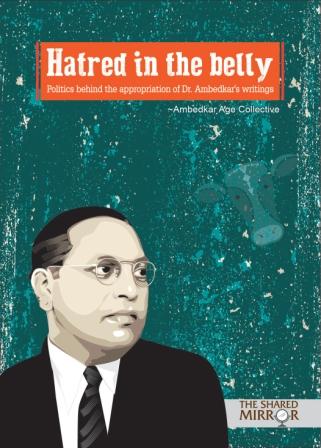Tejaswini Tabhane
 When Ambedkar asked us to ‘fight against Hindu Raj’ he was not aware that one day the same propagandists of Hindu Raj will start (mis)appropriating his ideals. The fashion of saffronising Ambedkar has gained a new pace ever since the Narendra Modi-led National Democratic Alliance (NDA) government came to power in 2014. Their recent effort in this direction is the visit of Modi to Deeksha Bhoomi, Nagpur, on April 14 — Ambedkar’s 126th birth anniversary. This visit has various political and ideological aspects which need to be discussed.
When Ambedkar asked us to ‘fight against Hindu Raj’ he was not aware that one day the same propagandists of Hindu Raj will start (mis)appropriating his ideals. The fashion of saffronising Ambedkar has gained a new pace ever since the Narendra Modi-led National Democratic Alliance (NDA) government came to power in 2014. Their recent effort in this direction is the visit of Modi to Deeksha Bhoomi, Nagpur, on April 14 — Ambedkar’s 126th birth anniversary. This visit has various political and ideological aspects which need to be discussed.
Deeksha Bhoomi is the place where Babasaheb embraced Buddhism and kept his words, “even though I was born in the Hindu religion, I will not die in the Hindu religion.” It has a special place in the heart of every Ambedkarite and gives us an inspiration to fight Brahmin hegemony. Lakhs of people from all over India come here to celebrate Ambedkar Jayanti. Many among them are not financially capable to pay for their accommodation so they stay within the Deeksha Bhoomi and Dr. Ambedkar College campus. But this year, due to our prime minister’s high profile visit to this place, no one was allowed to stay inside the monument. The main gate was closed till 12:30 pm, and the path in front of Deeksha Bhoomi was completely blocked. People were allowed entry inside the stupa through the south entrance gate and were made to leave through west gateway. The distance between the two is roughly 800 metres. So we had to walk this long distance just to visit our own Deeksha Bhoomi, not to mention, in the killing heat of Nagpur where temperature had nearly touched the 40 degree mark.
Inside the stupa they did not allow us to stay for more than 10 minutes. Every now and then the cops reminded us that we had to leave the place since the Prime Minister was coming. The event has a huge market for booksellers and artisans who wait for this day to come and earn some money. But this year as no stalls were allowed, they suffered huge losses. Though the area was opened after prime minister’s visit, the number of stalls were less than usual.
As most people from outside Nagpur prefer a morning visit to Deeksha Bhoomi, majority of them faced inconvenience. There is nothing wrong for any prime minister to come here but they must be aware of the impact their visit would have on ordinary citizens. Ambedkar Jayanti was certainly not a right day for such a VVIP person to come here. If you, Mr. Modi, really want to pay tribute to Babasaheb, then strive for annihilation of caste and to establish an egalitarian society. But I guess this will be too much to ask of a person who thinks manual scavenging is ‘spiritual work’.
It is important to note that, for a long time Ambedkar’s legacy did not find a notable place in the state and civil society. He was more popular among Dalit–Bahujan masses than India’s right wing which always opposed him and branded him as a “stooge,” a “traitor” and what not. The Dalit–Bahujans tirelessly preserved and promoted Ambedkar and his thoughts. But the sudden feeling of love for Babasaheb among the right wing brigade is indeed an example of classic paradox since their history is one of opposing him throughout his life. So what has forced the right wing to pay reverence to him now? The contemporary Dalit–Bahujan mobilisation, which manifests itself through a politicised Buddhist identity and the creation of an alternative celebratory space, is emerging as a challenge. The growing number of student outfits which identify themselves with Ambedkarite philosophy is causing serious anxiety among the right.
Modi’s visit to Nagpur was strategically planned to send a message that his government stands with the oppressed classes, whose upliftment was the prime objective of Dr. Ambedkar. Thus he cleverly avoided going to Rashtriya Swayamsevak Sangh (RSS) headquarters as it would have shown his dubious intentions. One can see the hollowness of his claims by simply listing out the statistics of National Crime Records Bureau (NCRB) on atrocities committed against Dalits in ‘Vibrant Gujarat’. The 2016 Una incident is no exception as Gujarat has a long history of oppression of Dalits. There is an old proverb ‘Qui tacet consentire videtur’ which means silence implies consent. Modi’s mysterious silence on everything from Rohith Vemula to Una speaks volumes about his approval of all kinds of oppression of Dalits.
The right wing agenda is a threat to the pluralist and egalitarian ideas of Babasaheb and his precious legacy. Dalits should personally fight against it. We should prevent the saffron trying to commingle with blue. Dalits should note that we cannot afford to lose our only inspiration — Dr. Babasaheb Ambedkar.
Let them try to appropriate Ambedkar and we will make them realise it is not an easy task. I would like to conclude this piece with the words of Rohith Vemula, “Arey, what will we lose if we revolt against these Hindutva schemes? Food? Itihaas ke shuruvaat se hum bhooke hein bhai [We have been hungry since the beginning of history]. What’s new? Are we scared of getting beaten?? Forgot the atrocities and pogroms we faced in this society? Take a stand before it is too late. “The question is no longer whether you are a Mala or a Madiga [two SC sub-castes] or a like minded progressive. The question today is whether you are an Ambedkarite or a Bharatiya Janata Party (BJP) boot licker” (from the book Caste Is Not A Rumour: The Online Diary of Rohith Vemula).
Resist before it’s too late.
Jai Bhim!
~~~
Tejaswini Tabhane is a 17-year-old student from Nagpur and a budding Ambedkarite.










